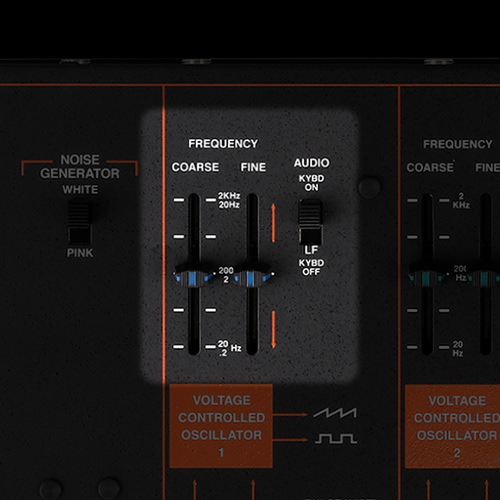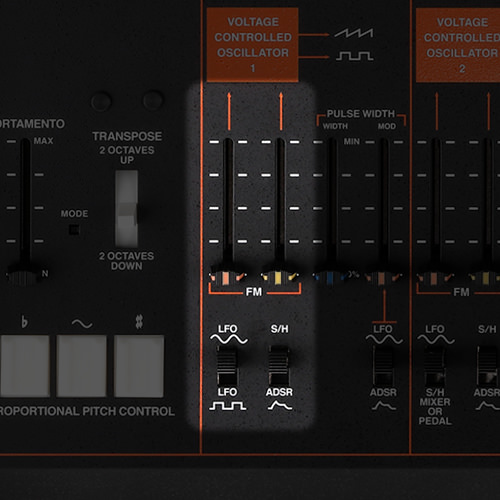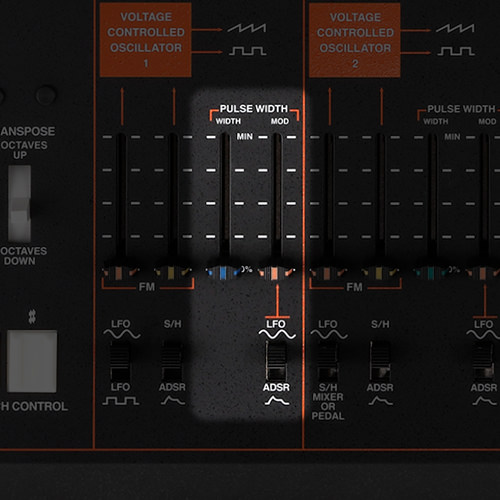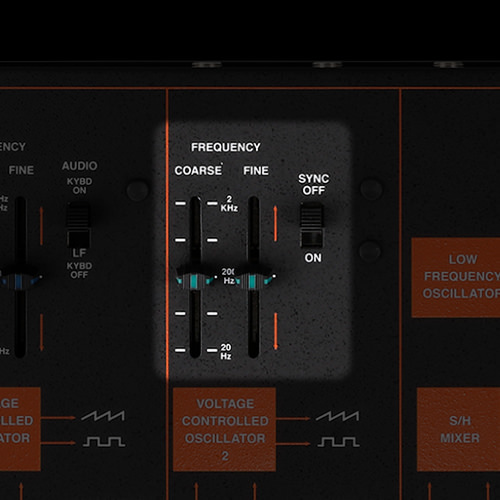TUTORIAL: VCO
2015.07.24In this series of tutorials, we will explore the parameters and history of the legendary ARP Odyssey in its current, reissued form. Here, we discuss the VCO.
Text: Ryota Hayashida (Iroha Studio)

VCO1
The ARP Odyssey is equipped with two VCOs (Voltage-Controlled Oscillators). Although there are slight differences, the two have essentially the same specifications. However, they feature a “duophonic” relationship in which different pitches are sent to the two VCOs when you press two keys simultaneously.
Functionality similar to this duophonic design was also used on the classic Korg Mono/Poly kin the mid 80’s, but there were very few of these models available. The ARP Odyssey functions as a pseudo-duophonic polyphonic synth. Functionally, there are limitations in how the decay is maintained, but you play the intended chords if the two VCOs are set to the same pitch. The pitch of the ARP Odyssey’s VCO can be adjusted in the range from 20 Hz to 2 kHz. This extremely bold, wide modulation gives you plenty of freedom for movement, so first use COARSE to set the approximately pitch and use FINE to make detailed adjustments. To achieve the correct tuning, it’s a good idea to have a tuner. Although it’s more typical for a VCO to use an octave select switch to change the pitch, there are plenty of sounds that can be achieved only with this variable type. The ARP Odyssey’s choice of the variable type might be an example of the company’s traditional attitude. (In actuality, most of the early models used variable pitch.)
The AUDIO switch gives you a choice between KYBD ON which gives you conventional VCO operation, and KYBD OFF which lets you lower the frequency and use VCO1 as an LFO (discussed later). If the VCO is used as an LFO, it obviously will not follow the keyboard. Perhaps you’re not familiar with the idea of using the VCO as an LFO, but the only difference is that a VCO and an LFO are outputting different frequencies. If you use VCO1 as an LFO, you’ll have only one oscillator, VCO2, but you’ll have two LFOs, which lets you apply complex modulation.The lower row of sliders essentially specify the source that apply modulation to the VCO and specify the depth of this modulation.

The two sliders marked FM are for modulating the pitch. FM stands for Frequency Modulation. As sources, you can use two LFO waveforms and S/H (Sample & Hold) or ADSR (envelope generator). Using the LFO as a source lets you apply vibrato, and using S/H produces random pitch change (a variety of uses can be imagined depending on the S/H settings). ADSR is often used to create electronic drum-type sounds. If you want to create percussive sounds, try using the ADSR to modulate the pitch.

The two sliders beside these are for modulating the width of a pulse wave.
Before we talk about pulse waves, let’s take a look at the two waveforms provided by the ARP Odyssey. Each of the two VCOs can output two waveforms: sawtooth wave and pulse wave. You’ll choose one of these depending on the sound that you want to create. These two waveforms are typical for an analog synthesizer, and are decisively different in their overtone structure. When you look at a sawtooth wave in an oscilloscope, it looks like the teeth of a saw (which accounts for its name), but the overtones that determine the tonal character of the sound (relative to the fundamental, which determines the pitch of the sound) include both the odd-numbered and even-numbered overtones. Since this is similar to the overtone structure of most instrumental sounds, the sawtooth wave is commonly used as a standard waveform, providing an uncolored sound that’s easy to use.
In contrast, a pulse wave seen in an oscilloscope has a square or rectangular shape. Its overtone structure contains just the odd-numbered overtones, making it similar to the overtone structure of a clarinet.
Unlike a sawtooth wave, the shape of a pulse wave has a “top side” and “bottom side” that cyclically alternate. Adjusting the width of the top and bottom sides will significantly change the overtone structure and therefore the tone. WIDTH manually adjusts the pulse width; when the slider is at the lowest position, the width of the pulse wave is 50%/50%, producing the fattest sound. Raising the slider makes this percentage uneven, causing the sound to become sharper.
MOD modulates the pulse width using either the LFO or ADSR as a source. Often used is the technique of using the LFO to modulate the pulse width, which for some reason creates the impression that multiple VCOs are being heard (even if there is really just one VCO), and this distinctive sense of movement is one of the classic analog synthesizer sounds.
In particular, the ARP Odyssey’s pulse wave has a truly unique sound, and (in a good sense) is not typical of pulse waves. The low-frequency region is not as emphasized as a modern analog synthesizer. Instead, the region slightly higher has more weight, making it stand out in an ensemble. There are too many elements for me to explain this logically, but it is certain that longtime ARP Odyssey fans are drawn by this pulse wave. Another frequently used technique is to use one of the VCOs as a sawtooth wave, the other VCO as a pulse wave, and mix the two. I mentioned the numerous overtones of a sawtooth wave, but you may also get the impression that it produces a sharper sound than the pulse wave. Instead of applying logic, it’s best to let your ears make this decision.

VCO2
VCO2 is essentially the same as VCO1; the only difference is the SYNC switch. This is called oscillator sync, and is a function that forcibly synchronizes the pitch of VCO2 to VCO1. If this is on, VCO2 will function as overtones of VCO1, but if you deliberately skew the pitch of VCO2 you’ll get a very extreme and bright sound. You might even call it ear-piercing! The oscillator sync function itself is often seen on two-VCO type synthesizers, but of these, the ARP Odyssey was renowned for the hardness of its oscillator sync. Cool-sounding oscillator sync was a specialty of the ARP Odyssey.
A popular technique was to turn oscillator sync on and use ADSR to apply FM to VCO2. If oscillator sync is being applied, you don’t need to use a tuner to set the VCO2 COARSE position. VCO2 is functioning as an overtone, so you can move it freely. The trick is that it has to be at a higher pitch than VCO1 when applying modulation. This will produce a more sparkling effect. Set the ADSR to a fairly low sustain and a long decay. Once you hear this sound, you’ll understand for yourself the originality of the ARP Odyssey, and how it took an entirely different path than its rival models. Depending on the settings, it’s possible to create sounds that are as expressive as a human voice, letting the instrument behave like a living creature.
Yet another technique is to use the duophonic function mentioned earlier, and play chords with oscillator sync deliberately applied. A mysterious world will appear before you.

 LFO
LFO